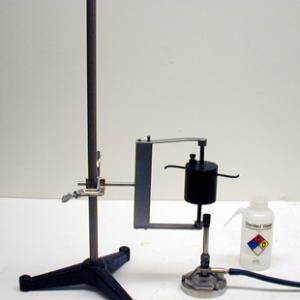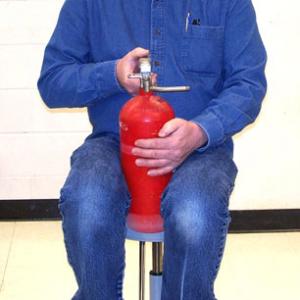College of Liberal Arts & Sciences
4F30.01 - Hero's Engine
Pour boiling water into the engine reservoir until the unit is about half full. Reseal airtight as this demo works on increased internal pressure. Place the Bunsen burner under the unit as indicated for several minutes. The unit will start to rotate when the water inside starts to boil and will continue until the water boils away or the flame is removed. Always empty this unit after use as any small buildup of minerals will plug the outlet tubes.
Another example of a boiling liquid that can be used in Hero's engine is liquid nitrogen. The bottom portion of the cylinder will have to be cooled in liquid nitrogen for several minutes before you will be able to put an appreciable amount in the engine. Warming the liquid nitrogen with a Bunsen burner or a flame will cause it to boil. The engine should act the same as with water.
You can make yourself into a pseudo Hero's engine by using one of the special demonstration fire extinguishers with the tube that can be pointed in different directions. You will rotate in the direction opposite the discharge.
Note that a regular fire extinguisher will not work for this demonstration.
- Thomas B. Greenslade Jr., "Apparatus Named After Our Academic Ancestors - VII", TPT, Vol. 62, #8, Nov. 2024, p. 636.
- B. T. G. Tan, "Physics and the Development of Railway Steam Engines", TPT, Vol. 57, #8, Nov. 2019, p. 538.
- Thomas B. Greenslade Jr., "Aeliophile (Photo)", AJP, Vol. 70, #5, May 2002, p. 512.
- Thomas B. Greenslade Jr., "Hero's Engine (Photo)", AJP, Vol. 70, #5, May 2002, p. 481.
- Lester Hirsch, "An Improved Hero's Engine", AJP, Vol. 46, #7, July 1978, p. 773.
- G. D. Freier and F. J. Anderson, "Hn-5", A Demonstration Handbook for Physics.
- George M. Hopkins, "Mouth Vacuum Apparatus", Experimental Science, p. 106.
- A. D. Bulman, "Jet Propulsion", Model-Making for Physics, p. 76.
- John Henry Pepper, Henry George Hine, The Boy's Playbook of Science, p. 418.
- Rick Beyer, "Ancient Hero", The Greatest Science Stories Never Told, p. 6.
- Julien Clinton Sprott, "2.5, Hero's Engine", Physics Demonstrations, ISBN 0-299-21580-6, p. 77.
- Robert L. Wild, "Hero's Engine", Low-Cost Physics Demonstrations, #20, p. 14.
- Simon Quellen Field, "Hero's Steam Engine", Gonzo Gizmos, p. 136 - 141.
- Robert Ehrlich, "Hero's Engine Made From a Soda Can", Why Toast Lands Jelly-Side Down, p. 69 - 71.
- "Driven by Ideas, Ancient Engineers had the Scientific Knowledge to Build a Steam Engine", The Truth About History, Readers Digest, ISBN 0-7621-0523-2.
- Aubrey F. Burstall, "Hero's Whirling Aeolipile", Simple Working Models of Historic Machines, p. 78.
- Joseph Frick, "# 366 - Heros' Rotating Ball", Physical Technics: Or Practical Instructions for Making Experiments in Physics and the Construction of Physical Apparatus with the Most Limmited Means, p. 439.
Disclaimer: These demonstrations are provided only for illustrative use by persons affiliated with The University of Iowa and only under the direction of a trained instructor or physicist. The University of Iowa is not responsible for demonstrations performed by those using their own equipment or who choose to use this reference material for their own purpose. The demonstrations included here are within the public domain and can be found in materials contained in libraries, bookstores, and through electronic sources. Performing all or any portion of any of these demonstrations, with or without revisions not depicted here entails inherent risks. These risks include, without limitation, bodily injury (and possibly death), including risks to health that may be temporary or permanent and that may exacerbate a pre-existing medical condition; and property loss or damage. Anyone performing any part of these demonstrations, even with revisions, knowingly and voluntarily assumes all risks associated with them.

